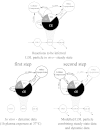In silico modeling of the dynamics of low density lipoprotein composition via a single plasma sample
- PMID: 27015744
- PMCID: PMC4847624
- DOI: 10.1194/jlr.M058446
In silico modeling of the dynamics of low density lipoprotein composition via a single plasma sample
Abstract
Lipoproteins play a key role in the development of CVD, but the dynamics of lipoprotein metabolism are difficult to address experimentally. This article describes a novel two-step combined in vitro and in silico approach that enables the estimation of key reactions in lipoprotein metabolism using just one blood sample. Lipoproteins were isolated by ultracentrifugation from fasting plasma stored at 4°C. Plasma incubated at 37°C is no longer in a steady state, and changes in composition may be determined. From these changes, we estimated rates for reactions like LCAT (56.3 µM/h), β-LCAT (15.62 µM/h), and cholesteryl ester (CE) transfer protein-mediated flux of CE from HDL to IDL/VLDL (21.5 µM/h) based on data from 15 healthy individuals. In a second step, we estimated LDL's HL activity (3.19 pools/day) and, for the very first time, selective CE efflux from LDL (8.39 µM/h) by relying on the previously derived reaction rates. The estimated metabolic rates were then confirmed in an independent group (n = 10). Although measurement uncertainties do not permit us to estimate parameters in individuals, the novel approach we describe here offers the unique possibility to investigate lipoprotein dynamics in various diseases like atherosclerosis or diabetes.
Keywords: lecithin:cholesterol acyltransferase; lipase/hepatic; lipid transfer proteins; lipoproteins/kinetics; low density lipoprotein/metabolism.
Copyright © 2016 by the American Society for Biochemistry and Molecular Biology, Inc.
Figures



References
-
- Austin M. A., King M. C., Vranizan K. M., and Krauss R. M.. 1990. Atherogenic lipoprotein phenotype. A proposed genetic marker for coronary heart disease risk. Circulation. 82: 495–506. - PubMed
-
- Austin M. A., Breslow J. L., Hennekens C. H., Buring J. E., Willett W. C., and Krauss R. M.. 1988. Low-density lipoprotein subclass patterns and risk of myocardial infarction. J. Am. Med. Assoc. 260: 1917–1921. - PubMed
-
- Grammer T. B., Kleber M. E., März W., Silbernagel G., Siekmeier R., Wieland H., Pilz S., Tomaschitz A., Koenig W., and Scharnagl H.. 2015. Low-density lipoprotein particle diameter and mortality: the Ludwigshafen Risk and Cardiovascular Health Study. Eur. Heart J. 36: 31–38. - PubMed
-
- Barter P. J. 1983. Evidence that lecithin:cholesterol acyltransferase acts on both high-density and low-density lipoproteins. Biochim. Biophys. Acta. 751: 261–270. - PubMed
MeSH terms
Substances
LinkOut - more resources
Full Text Sources
Other Literature Sources
Miscellaneous

